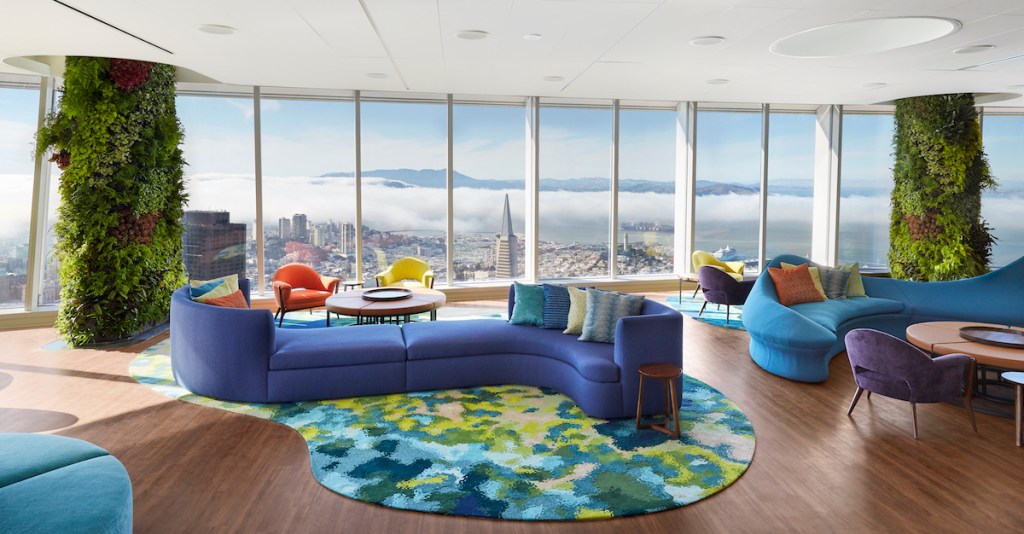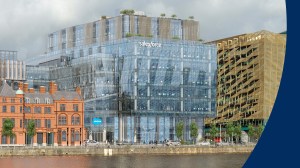Today, we’re releasing the second volume of Salesforce’s Healthy & Sustainable Materials Guide, outlining Salesforce’s commitment to the latest sustainability and health standards in our workspaces. This updated guide builds on the foundation we created four years ago, further increasing transparency around how we source materials for our buildings and create healthy spaces for all of our stakeholders — employees, customers, partners, communities, and the planet.
Sustainable buildings are a critical component of improving the health of our planet, climate, and people. On average, people spend about 90% of our time inside buildings, and today’s buildings generate nearly 40% of annual global emissions. Embodied carbon — emissions associated with the extraction, manufacturing, transportation, and installation of building materials before and after their use — will make up make up a majority of built environment emissions between now and 2040.
As part of Salesforce’s Climate Action Plan, the healthy and sustainable materials in our buildings are a key part of our net zero achievement. We have made a commitment to pursue Zero Carbon Certification on our new major building projects and reduce our embodied carbon impact by 80% by 2030. Through our efforts to date, we’ve already achieved a 20% reduction in embodied carbon. By focusing on our most impactful materials, we plan to drive down our impact even further.

Measuring and mitigating our footprint in the built environment
As Salesforce has grown, we’ve implemented new strategies to more effectively evaluate the materials we bring into our spaces. Our sustainability team uses a streamlined scoring method to evaluate products based on a set of criteria and assign a numerical value that can be easily interpreted by our real estate, design, and procurement teams.
Today, we evaluate products based on five criteria — Health, Carbon, Circularity, Resource Efficiency, and Social & Governance — with an increased focus on embodied carbon. By integrating these requirements into our design guidelines, contract language, and procurement decisions, we create a healthier environment for everyone who walks through our doors.
- Health: There are tens of thousands of chemicals that go into building materials and furnishings, and while many of these chemicals are proven to be harmful to human health, very few are federally regulated in the United States. At Salesforce, we ask for transparency around materials ingredients from our vendors and continuously work with manufacturers to eliminate chemicals of concern from building products.
- Carbon: The building industry accounts for 39% of global greenhouse gas emissions, creating urgency to measure, reduce, and eliminate the carbon emissions of our real estate. In 2018, we committed to Zero Carbon Certification for all our new major workplaces and we’re working with suppliers to catalyze their climate action.
- Circularity: We evaluate how well materials can be used and reused so that natural resources can regenerate at the same rate they are extracted. These considerations are relevant to the entire lifecycle of a project, from the early stages of real estate planning all the way through design, construction, operations, and decommissioning.
- Resource Efficiency: We evaluate our suppliers’ environmental management plans to reduce waste and environmental impacts at all stages of the product lifecycle. We believe that when we work together, we can preserve our most precious resources.
- Social & Governance: We evaluate a manufacturer’s commitment to diversity, equity, and inclusion, as well as their efforts to have a positive impact on local communities. We believe a supplier’s social responsibility also extends throughout their entire value chain, and should include commitments to human rights policies and equitable treatment of all people involved or impacted in the production of materials.
Pushing the industry forward
At Salesforce, we believe we are responsible for pushing the industry forward and using our business as a platform for change. Today, manufacturers are addressing a broader array of sustainability issues, new standards and certifications are emerging, and decision-makers have access to more product data than ever before. With all of this available information, our scoring method has become even more impactful in driving the sustainability of our supply chain.
As manufacturers have become more familiar with reporting practices, we’re able to ask for more detailed information about the impacts of their products. While we align with many third-party reporting standards that help create consistent industry-wide reporting and policies, we often ask manufacturers for metrics that go above and beyond industry standards.
As we stand in the midst of a critical moment — one with profound consequences for our collective futures — we must take immediate action to reduce our impact on the environment. With this new guide, we’re sharing our insights and lessons learned to help companies scale their workplace sustainability programs. Together, we can create a better future through sustainable, healthy real estate.
Learn more about Salesforce’s Healthy & Sustainable Materials program and download the guide here.



















